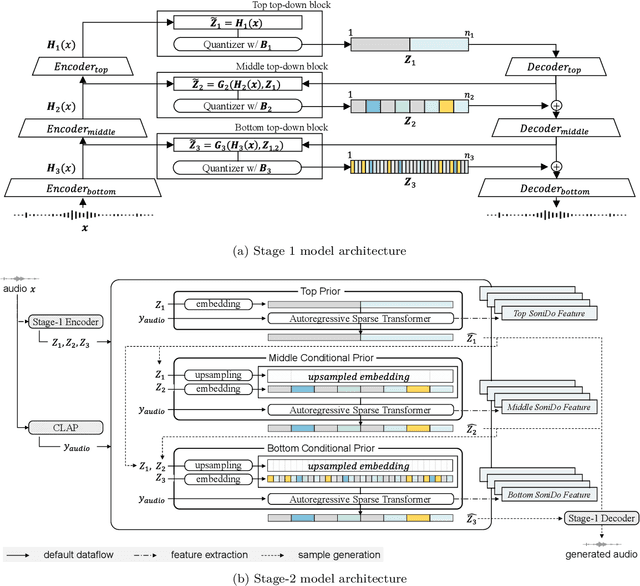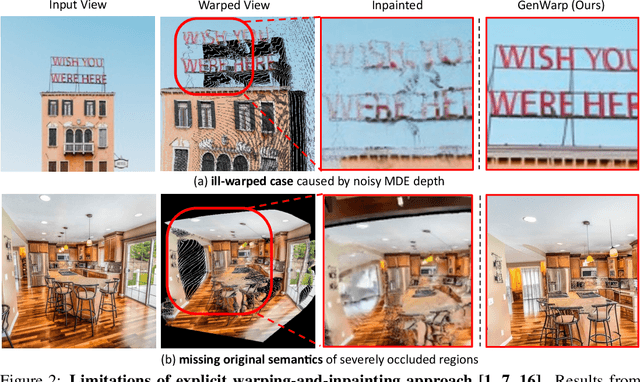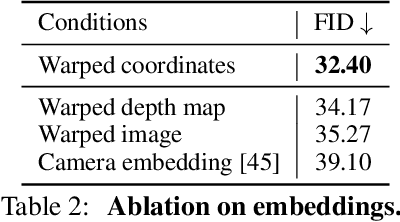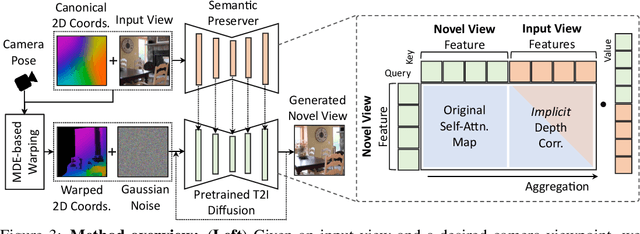Chieh-Hsin Lai
Training Consistency Models with Variational Noise Coupling
Feb 25, 2025Abstract:Consistency Training (CT) has recently emerged as a promising alternative to diffusion models, achieving competitive performance in image generation tasks. However, non-distillation consistency training often suffers from high variance and instability, and analyzing and improving its training dynamics is an active area of research. In this work, we propose a novel CT training approach based on the Flow Matching framework. Our main contribution is a trained noise-coupling scheme inspired by the architecture of Variational Autoencoders (VAE). By training a data-dependent noise emission model implemented as an encoder architecture, our method can indirectly learn the geometry of the noise-to-data mapping, which is instead fixed by the choice of the forward process in classical CT. Empirical results across diverse image datasets show significant generative improvements, with our model outperforming baselines and achieving the state-of-the-art (SoTA) non-distillation CT FID on CIFAR-10, and attaining FID on par with SoTA on ImageNet at $64 \times 64$ resolution in 2-step generation. Our code is available at https://github.com/sony/vct .
Consistency Training with Physical Constraints
Feb 11, 2025Abstract:We propose a physics-aware Consistency Training (CT) method that accelerates sampling in Diffusion Models with physical constraints. Our approach leverages a two-stage strategy: (1) learning the noise-to-data mapping via CT, and (2) incorporating physics constraints as a regularizer. Experiments on toy examples show that our method generates samples in a single step while adhering to the imposed constraints. This approach has the potential to efficiently solve partial differential equations (PDEs) using deep generative modeling.
Music Foundation Model as Generic Booster for Music Downstream Tasks
Nov 05, 2024



Abstract:We demonstrate the efficacy of using intermediate representations from a single foundation model to enhance various music downstream tasks. We introduce SoniDo, a music foundation model (MFM) designed to extract hierarchical features from target music samples. By leveraging hierarchical intermediate features, SoniDo constrains the information granularity, leading to improved performance across various downstream tasks including both understanding and generative tasks. We specifically evaluated this approach on representative tasks such as music tagging, music transcription, music source separation, and music mixing. Our results reveal that the features extracted from foundation models provide valuable enhancements in training downstream task models. This highlights the capability of using features extracted from music foundation models as a booster for downstream tasks. Our approach not only benefits existing task-specific models but also supports music downstream tasks constrained by data scarcity. This paves the way for more effective and accessible music processing solutions.
$\textit{Jump Your Steps}$: Optimizing Sampling Schedule of Discrete Diffusion Models
Oct 10, 2024



Abstract:Diffusion models have seen notable success in continuous domains, leading to the development of discrete diffusion models (DDMs) for discrete variables. Despite recent advances, DDMs face the challenge of slow sampling speeds. While parallel sampling methods like $\tau$-leaping accelerate this process, they introduce $\textit{Compounding Decoding Error}$ (CDE), where discrepancies arise between the true distribution and the approximation from parallel token generation, leading to degraded sample quality. In this work, we present $\textit{Jump Your Steps}$ (JYS), a novel approach that optimizes the allocation of discrete sampling timesteps by minimizing CDE without extra computational cost. More precisely, we derive a practical upper bound on CDE and propose an efficient algorithm for searching for the optimal sampling schedule. Extensive experiments across image, music, and text generation show that JYS significantly improves sampling quality, establishing it as a versatile framework for enhancing DDM performance for fast sampling.
Human-Feedback Efficient Reinforcement Learning for Online Diffusion Model Finetuning
Oct 07, 2024Abstract:Controllable generation through Stable Diffusion (SD) fine-tuning aims to improve fidelity, safety, and alignment with human guidance. Existing reinforcement learning from human feedback methods usually rely on predefined heuristic reward functions or pretrained reward models built on large-scale datasets, limiting their applicability to scenarios where collecting such data is costly or difficult. To effectively and efficiently utilize human feedback, we develop a framework, HERO, which leverages online human feedback collected on the fly during model learning. Specifically, HERO features two key mechanisms: (1) Feedback-Aligned Representation Learning, an online training method that captures human feedback and provides informative learning signals for fine-tuning, and (2) Feedback-Guided Image Generation, which involves generating images from SD's refined initialization samples, enabling faster convergence towards the evaluator's intent. We demonstrate that HERO is 4x more efficient in online feedback for body part anomaly correction compared to the best existing method. Additionally, experiments show that HERO can effectively handle tasks like reasoning, counting, personalization, and reducing NSFW content with only 0.5K online feedback.
Bellman Diffusion: Generative Modeling as Learning a Linear Operator in the Distribution Space
Oct 02, 2024



Abstract:Deep Generative Models (DGMs), including Energy-Based Models (EBMs) and Score-based Generative Models (SGMs), have advanced high-fidelity data generation and complex continuous distribution approximation. However, their application in Markov Decision Processes (MDPs), particularly in distributional Reinforcement Learning (RL), remains underexplored, with conventional histogram-based methods dominating the field. This paper rigorously highlights that this application gap is caused by the nonlinearity of modern DGMs, which conflicts with the linearity required by the Bellman equation in MDPs. For instance, EBMs involve nonlinear operations such as exponentiating energy functions and normalizing constants. To address this, we introduce Bellman Diffusion, a novel DGM framework that maintains linearity in MDPs through gradient and scalar field modeling. With divergence-based training techniques to optimize neural network proxies and a new type of stochastic differential equation (SDE) for sampling, Bellman Diffusion is guaranteed to converge to the target distribution. Our empirical results show that Bellman Diffusion achieves accurate field estimations and is a capable image generator, converging 1.5x faster than the traditional histogram-based baseline in distributional RL tasks. This work enables the effective integration of DGMs into MDP applications, unlocking new avenues for advanced decision-making frameworks.
Latent Diffusion Bridges for Unsupervised Musical Audio Timbre Transfer
Sep 09, 2024Abstract:Music timbre transfer is a challenging task that involves modifying the timbral characteristics of an audio signal while preserving its melodic structure. In this paper, we propose a novel method based on dual diffusion bridges, trained using the CocoChorales Dataset, which consists of unpaired monophonic single-instrument audio data. Each diffusion model is trained on a specific instrument with a Gaussian prior. During inference, a model is designated as the source model to map the input audio to its corresponding Gaussian prior, and another model is designated as the target model to reconstruct the target audio from this Gaussian prior, thereby facilitating timbre transfer. We compare our approach against existing unsupervised timbre transfer models such as VAEGAN and Gaussian Flow Bridges (GFB). Experimental results demonstrate that our method achieves both better Fr\'echet Audio Distance (FAD) and melody preservation, as reflected by lower pitch distances (DPD) compared to VAEGAN and GFB. Additionally, we discover that the noise level from the Gaussian prior, $\sigma$, can be adjusted to control the degree of melody preservation and amount of timbre transferred.
DisMix: Disentangling Mixtures of Musical Instruments for Source-level Pitch and Timbre Manipulation
Aug 20, 2024



Abstract:Existing work on pitch and timbre disentanglement has been mostly focused on single-instrument music audio, excluding the cases where multiple instruments are presented. To fill the gap, we propose DisMix, a generative framework in which the pitch and timbre representations act as modular building blocks for constructing the melody and instrument of a source, and the collection of which forms a set of per-instrument latent representations underlying the observed mixture. By manipulating the representations, our model samples mixtures with novel combinations of pitch and timbre of the constituent instruments. We can jointly learn the disentangled pitch-timbre representations and a latent diffusion transformer that reconstructs the mixture conditioned on the set of source-level representations. We evaluate the model using both a simple dataset of isolated chords and a realistic four-part chorales in the style of J.S. Bach, identify the key components for the success of disentanglement, and demonstrate the application of mixture transformation based on source-level attribute manipulation.
SoundCTM: Uniting Score-based and Consistency Models for Text-to-Sound Generation
May 28, 2024Abstract:Sound content is an indispensable element for multimedia works such as video games, music, and films. Recent high-quality diffusion-based sound generation models can serve as valuable tools for the creators. However, despite producing high-quality sounds, these models often suffer from slow inference speeds. This drawback burdens creators, who typically refine their sounds through trial and error to align them with their artistic intentions. To address this issue, we introduce Sound Consistency Trajectory Models (SoundCTM). Our model enables flexible transitioning between high-quality 1-step sound generation and superior sound quality through multi-step generation. This allows creators to initially control sounds with 1-step samples before refining them through multi-step generation. While CTM fundamentally achieves flexible 1-step and multi-step generation, its impressive performance heavily depends on an additional pretrained feature extractor and an adversarial loss, which are expensive to train and not always available in other domains. Thus, we reframe CTM's training framework and introduce a novel feature distance by utilizing the teacher's network for a distillation loss. Additionally, while distilling classifier-free guided trajectories, we train conditional and unconditional student models simultaneously and interpolate between these models during inference. We also propose training-free controllable frameworks for SoundCTM, leveraging its flexible sampling capability. SoundCTM achieves both promising 1-step and multi-step real-time sound generation without using any extra off-the-shelf networks. Furthermore, we demonstrate SoundCTM's capability of controllable sound generation in a training-free manner.
GenWarp: Single Image to Novel Views with Semantic-Preserving Generative Warping
May 27, 2024



Abstract:Generating novel views from a single image remains a challenging task due to the complexity of 3D scenes and the limited diversity in the existing multi-view datasets to train a model on. Recent research combining large-scale text-to-image (T2I) models with monocular depth estimation (MDE) has shown promise in handling in-the-wild images. In these methods, an input view is geometrically warped to novel views with estimated depth maps, then the warped image is inpainted by T2I models. However, they struggle with noisy depth maps and loss of semantic details when warping an input view to novel viewpoints. In this paper, we propose a novel approach for single-shot novel view synthesis, a semantic-preserving generative warping framework that enables T2I generative models to learn where to warp and where to generate, through augmenting cross-view attention with self-attention. Our approach addresses the limitations of existing methods by conditioning the generative model on source view images and incorporating geometric warping signals. Qualitative and quantitative evaluations demonstrate that our model outperforms existing methods in both in-domain and out-of-domain scenarios. Project page is available at https://GenWarp-NVS.github.io/.
 Add to Chrome
Add to Chrome Add to Firefox
Add to Firefox Add to Edge
Add to Edge